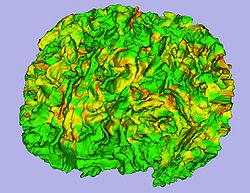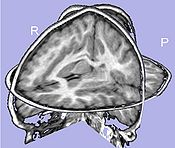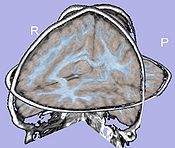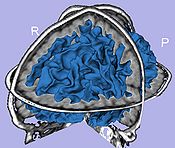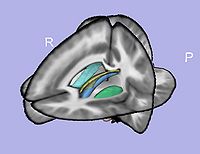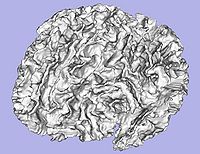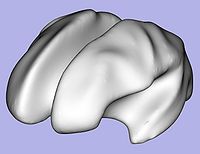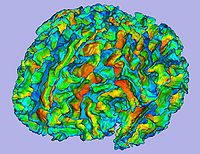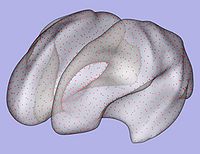Difference between revisions of "DBP2:UNC:Local Cortical Thickness Pipeline"
From NAMIC Wiki
| Line 1: | Line 1: | ||
Back to [[DBP2:UNC:Cortical_Thickness_Roadmap | UNC Cortical Thickness Roadmap]] | Back to [[DBP2:UNC:Cortical_Thickness_Roadmap | UNC Cortical Thickness Roadmap]] | ||
| + | [[Image:MeshBasedCortThick_CorticalThickness.jpg|thumb|250px|Cortical thickness on white matter cortical surface]] | ||
== Objective == | == Objective == | ||
We would like to create end-to-end applications within Slicer3 allowing individual and group analysis of mesh-based local cortical thickness. | We would like to create end-to-end applications within Slicer3 allowing individual and group analysis of mesh-based local cortical thickness. | ||
| + | |||
| + | |||
| + | == Pipeline overview == | ||
| + | |||
| + | <div style="margin: 20px;"> | ||
| + | <div style="width: 42%; float: left; padding-right: 3%;"> | ||
| + | |||
| + | Input: RAW images (T1-weighted, T2-weighted, PD-weighted images) | ||
| + | |||
| + | * '''1. Tissue segmentation''' | ||
| + | ** Probabilistic atlas-based automatic tissue segmentation via an Expectation-Maximization scheme | ||
| + | ** Tool: itkEMS (UNC Slicer3 external module) | ||
| + | * '''2. Atlas-based ROI segmentation:''' subcortical structures, lateral ventricles, parcellation | ||
| + | ** 2.1. Skull stripping using previously computed tissue segmentation label image | ||
| + | *** Tool: SegPostProcess (UNC Slicer3 external module) | ||
| + | ** 2.2. T1-weighted atlas deformable registration | ||
| + | *** B-spline pipeline registration | ||
| + | *** Tool: RegisterImages (Slicer3 module) | ||
| + | ** 2.3. Applying transformations to the structures | ||
| + | *** Tool: ResampleVolume2 (Slicer3 module) | ||
| + | * '''3. White matter map creation''' | ||
| + | ** Brainstem and cerebellum extraction | ||
| + | ** Adding subcortical structures except amygdala and hippocampus | ||
| + | ** Tool: ImageMath (UNC Slicer3 external module) | ||
| + | * '''4. White matter map post-processing''' | ||
| + | ** Largest component computation | ||
| + | ** Smoothing: Level set smoothing or weighted average filter | ||
| + | ** Connectivity enforcement (6-connectivity) | ||
| + | ** White matter filling | ||
| + | ** Tool: WMSegPostProcess (UNC Slicer3 external module) | ||
| + | * '''5. Genus zero white matter map image and surface creation''' | ||
| + | ** Tool: GenusZeroImageFilter (UNC Slicer3 external module) | ||
| + | * '''6. White matter surface inflation''' | ||
| + | ** Iterative smoothing using relaxation operator (considering average vertex) and L2 norm of the mean curvature as a stopping criterion | ||
| + | ** Iteration stopped if vertices that have too high curvature (some extremities) | ||
| + | ** Tool: MeshInflation (UNC Slicer3 external module) | ||
| + | * '''6 bis(Optional). White matter image fixing if necessary''' | ||
| + | ** Correction of the white matter map image (corresponding to vertices that have high curvature) with connectivity enforcement | ||
| + | ** Tool: FixImage (UNC Slicer3 external module) | ||
| + | ** Go back to step 5 | ||
| + | * '''7. Gray matter map creation''' | ||
| + | ** Adding genus zero white matter map to gray matter segmentation (without cerebellum and brainstem) | ||
| + | ** Tool: ImageMath | ||
| + | * '''8. Label map creation''' | ||
| + | ** Label map creation for cortical thickness computation (WM + GM + CSF) | ||
| + | ** Tool: ImageMath | ||
| + | * '''9. Cortical thickness''' | ||
| + | ** Asymmetric local cortical thickness or Laplacian cortical thickness | ||
| + | ** Tool: UNCCortThick or measureThicknessFilter (UNC Slicer3 external modules) | ||
| + | * '''10. Sulcal depth''' | ||
| + | ** Sulcal depth computation using genus zero surface and inflated one | ||
| + | ** Tool: MeshMath (UNC module) | ||
| + | * '''11. Cortical correspondence''' | ||
| + | ** Correspondence on inflated surfaces using particle system | ||
| + | ** Tools: ParticleCorrespondencePreProcessing, ParticleCorrespondence, ParticleCorrespondencePostProcessing (UNC Slicer3 external modules) | ||
| + | * '''12. Group statistical analysis''' | ||
| + | ** Tool: QDEC Slicer module or StatNonParamPDM | ||
| + | |||
| + | </div> | ||
| + | <div style="width: 55%; float: left;"> | ||
<center> | <center> | ||
{| | {| | ||
| − | |[[Image: | + | | [[Image:MeshBasedCortThick_T1Image.jpg|thumb|175px|T1-weighted image]] |
| − | + | | [[Image:MeshBasedCortThick_T1CorrectedImage.jpg|thumb|175px|T1 corrected image]] | |
| − | + | | [[Image:MeshBasedCortThick_T1LabelImage.jpg|thumb|175px|Label image]] | |
| − | + | | [[Image:MeshBasedCortThick_T1WMMesh.jpg|thumb|175px|White matter mesh]] | |
|} | |} | ||
| − | |||
| − | |||
{| | {| | ||
| − | |[[Image: | + | | [[Image:MeshBasedCortThick_BrainROIAtlas_AllROIMesh.jpg|thumb|200px|T1-weigthed atlas with subcortical structures]] |
| − | + | | [[Image:MeshBasedCortThick_T1StrippedAllROIMesh.jpg|thumb|200px|ROI segmentation on T1-weigthed stripped image]] | |
| − | + | |} | |
| + | {| | ||
| + | | [[Image:MeshBasedCortThick_WMMesh.jpg|thumb|200px|Genus-zero cortical surface]] | ||
| + | | [[Image:MeshBasedCortThick_WMMeshInflated.jpg|thumb|200px|Inflated cortical surface]] | ||
| + | |} | ||
| + | {| | ||
| + | | [[Image:MeshBasedCortThick_CorticalThickness.jpg|thumb|200px|Cortical thickness on genus-zero cortical surface]] | ||
| + | | [[Image:MeshBasedCortThick_CorticalThicknessInflated.jpg|thumb|200px|Cortical thickness on inflated genus-zero cortical surface]] | ||
| + | |} | ||
| + | {| | ||
| + | | [[Image:MeshBasedCortThick_SulcalDepth.jpg|thumb|200px|Sulcal depth on genus-zero cortical surface]] | ||
| + | | [[Image:MeshBasedCortThick_SulcalDepthInflated.jpg|thumb|200px|Sulcal depth on inflated genus-zero cortical surface]] | ||
| + | | [[Image:MeshBasedCortThick_Particles.jpg|thumb|200px|Particles on inflated genus-zero cortical surface]] | ||
|} | |} | ||
</center> | </center> | ||
| − | + | </div> | |
| − | + | </div> | |
| − | |||
| − | |||
| − | |||
| − | |||
| − | |||
| − | |||
| − | |||
| − | |||
| − | |||
| − | |||
| − | |||
| − | |||
| − | |||
| − | |||
| − | |||
| − | |||
| − | |||
| − | |||
| − | |||
| − | |||
| − | |||
| − | |||
| − | |||
| − | |||
| − | |||
| − | |||
| − | |||
| − | |||
| − | |||
| − | |||
| − | |||
| − | |||
| − | |||
| − | |||
| − | |||
| − | |||
| − | |||
| − | |||
| − | |||
| − | |||
| − | |||
| − | |||
| − | |||
| − | |||
| − | |||
| − | |||
| − | |||
| − | |||
| − | |||
== Download == | == Download == | ||
| Line 81: | Line 103: | ||
Tests will be computed on a small pediatric dataset which includes 2 year-old and 4 year-old cases. | Tests will be computed on a small pediatric dataset which includes 2 year-old and 4 year-old cases. | ||
| − | + | * 16 autistic cases | |
| − | + | * 1 developmental delay | |
| − | + | * 3 normal control | |
=== Comparison to state of the art === | === Comparison to state of the art === | ||
| Line 94: | Line 116: | ||
Steps 1 to 10: | Steps 1 to 10: | ||
| − | + | * Development of UNC Slicer3 modules (except itkEMS) | |
| − | + | * Modules applied on small pediatric dataset from the Autism study | |
=== In progress === | === In progress === | ||
| − | + | * Step 6: Parameter adjustment on autism dataset to fix bad vertices | |
| − | + | * Step 11: Particle correspondence testing with pediatric surfaces | |
=== Future work === | === Future work === | ||
| − | + | * Full pipeline working on pediatric dataset | |
| − | + | * Workflow for individual analysis as a Slicer3 high-level module using BatchMake | |
| − | + | * Workflow for group analysis | |
== References == | == References == | ||
Revision as of 21:15, 4 June 2009
Home < DBP2:UNC:Local Cortical Thickness PipelineBack to UNC Cortical Thickness Roadmap
Contents
Objective
We would like to create end-to-end applications within Slicer3 allowing individual and group analysis of mesh-based local cortical thickness.
Pipeline overview
Input: RAW images (T1-weighted, T2-weighted, PD-weighted images)
- 1. Tissue segmentation
- Probabilistic atlas-based automatic tissue segmentation via an Expectation-Maximization scheme
- Tool: itkEMS (UNC Slicer3 external module)
- 2. Atlas-based ROI segmentation: subcortical structures, lateral ventricles, parcellation
- 2.1. Skull stripping using previously computed tissue segmentation label image
- Tool: SegPostProcess (UNC Slicer3 external module)
- 2.2. T1-weighted atlas deformable registration
- B-spline pipeline registration
- Tool: RegisterImages (Slicer3 module)
- 2.3. Applying transformations to the structures
- Tool: ResampleVolume2 (Slicer3 module)
- 2.1. Skull stripping using previously computed tissue segmentation label image
- 3. White matter map creation
- Brainstem and cerebellum extraction
- Adding subcortical structures except amygdala and hippocampus
- Tool: ImageMath (UNC Slicer3 external module)
- 4. White matter map post-processing
- Largest component computation
- Smoothing: Level set smoothing or weighted average filter
- Connectivity enforcement (6-connectivity)
- White matter filling
- Tool: WMSegPostProcess (UNC Slicer3 external module)
- 5. Genus zero white matter map image and surface creation
- Tool: GenusZeroImageFilter (UNC Slicer3 external module)
- 6. White matter surface inflation
- Iterative smoothing using relaxation operator (considering average vertex) and L2 norm of the mean curvature as a stopping criterion
- Iteration stopped if vertices that have too high curvature (some extremities)
- Tool: MeshInflation (UNC Slicer3 external module)
- 6 bis(Optional). White matter image fixing if necessary
- Correction of the white matter map image (corresponding to vertices that have high curvature) with connectivity enforcement
- Tool: FixImage (UNC Slicer3 external module)
- Go back to step 5
- 7. Gray matter map creation
- Adding genus zero white matter map to gray matter segmentation (without cerebellum and brainstem)
- Tool: ImageMath
- 8. Label map creation
- Label map creation for cortical thickness computation (WM + GM + CSF)
- Tool: ImageMath
- 9. Cortical thickness
- Asymmetric local cortical thickness or Laplacian cortical thickness
- Tool: UNCCortThick or measureThicknessFilter (UNC Slicer3 external modules)
- 10. Sulcal depth
- Sulcal depth computation using genus zero surface and inflated one
- Tool: MeshMath (UNC module)
- 11. Cortical correspondence
- Correspondence on inflated surfaces using particle system
- Tools: ParticleCorrespondencePreProcessing, ParticleCorrespondence, ParticleCorrespondencePostProcessing (UNC Slicer3 external modules)
- 12. Group statistical analysis
- Tool: QDEC Slicer module or StatNonParamPDM
Download
Pipeline validation
Analysis on a small pediatric dataset
Tests will be computed on a small pediatric dataset which includes 2 year-old and 4 year-old cases.
- 16 autistic cases
- 1 developmental delay
- 3 normal control
Comparison to state of the art
We would like to compare our pipeline with FreeSurfer. We will thus perform a regional statistical analysis using Pearson's correlation coefficient on an adult dataset (FreeSurfer's publicly available tutorial dataset) including 40 cases.
Planning
Done
Steps 1 to 10:
- Development of UNC Slicer3 modules (except itkEMS)
- Modules applied on small pediatric dataset from the Autism study
In progress
- Step 6: Parameter adjustment on autism dataset to fix bad vertices
- Step 11: Particle correspondence testing with pediatric surfaces
Future work
- Full pipeline working on pediatric dataset
- Workflow for individual analysis as a Slicer3 high-level module using BatchMake
- Workflow for group analysis
References
- I. Oguz, M. Niethammer, J. Cates, R. Whitaker, T. Fletcher, C. Vachet, and M. Styner, Cortical Correspondence with Probabilistic Fiber Connectivity, Information Processing in Medical Imaging, IPMI 2009, LNCS, in print.
- H.C. Hazlett, C. Vachet, C. Mathieu, M. Styner, J. Piven, Use of the Slicer3 Toolkit to Produce Regional Cortical Thickness Measurement of Pediatric MRI Data, presented at the 8th Annual International Meeting for Autism Research (IMFAR) Chicago, IL 2009.
- C. Mathieu, C. Vachet, H.C. Hazlett, G. Geric, J. Piven, and M. Styner, ARCTIC – Automatic Regional Cortical ThICkness Tool, UNC Radiology Research Day 2009 abstract
- C. Vachet, H.C. Hazlett, M. Niethammer, I. Oguz, J.Cates, R. Whitaker, J. Piven, M. Styner, Mesh-based Local Cortical Thickness Framework, UNC Radiology Research Day 2009 abstract
